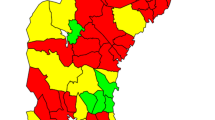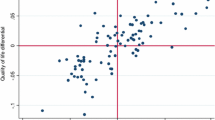Abstract
In recent years, a number of papers have looked at the adoption and diffusion of taxes across national, state, and local governments. Spending pressures, reductions in tax collection costs, median voter preferences, and social learning have been found to play an important role in the adoption of the income tax. Spatial econometrics were used to study the diffusions of income taxes across states from 1900 to 2010. Using United States Census Bureau data, negative spatial autocorrelation in income tax adoption was found. This is consistent with Tiebout competition reducing the likelihood of income tax adoption. States whose neighbors adopted income taxes were less likely to do so. This work informs the literature on policy diffusion as well as the understanding of why only some states utilize the income tax.
Similar content being viewed by others
References
Aidt, T., & Jensen, P. (2009). The taxman tools up: An event history study of the introduction of the personal income tax. Journal of Public Economics, 93(1), 160–175.
Baack, B., & Ray, E. (1985). Special interests and the adoption of the income tax in the United States. Journal of Economic History, 45(3), 607–625.
Baicker, K. (2005). The spillover effects of state spending. Journal of Public Economics, 89(2), 529–544.
Berry, F., & Berry, W. (1992). Tax innovation in the states: Capitalizing on political opportunity. American Journal of Political Science, 36(3), 715–742.
Besley, T., & Case, A. (1995). Incumbent behavior: Vote-seeking, tax-setting, and yardstick competition. American Economic Review, 85(1), 25–45.
Cebula, R. (1990). A brief empirical note on the Tiebout hypothesis and state income tax policies. Public Choice, 67(1), 87–89.
Cebula, R. (2009). Migration and the Tiebout-Tullock hypothesis revisited. American Journal of Economics and Sociology, 68(2), 541–551.
Congleton, R. (2001). The politics of government growth. In W. Shughart II & L. Razzolini (Eds.), The Elgar companion to public choice (pp. 457–478). Cheltenham: Edward Elgar.
Freeman, P. K. (1985). Interstate communication among state legislators regarding energy policy innovation. Publius: The Journal of Federalism, 15(4), 99–112.
Gibson, C., & Jung, K. (2002). Historical census statistics on population totals by race, 1790 to 1990, and by Hispanic origin, 1790 to 1990, for the United States, regions, divisions, and states. Washington, DC: U.S. Census Bureau.
Hall, J., & Ross, J. (2010). Tiebout competition, yardstick competition, and tax instrument choice: Evidence from Ohio school districts. Public Finance Review, 38(6), 710–737.
Hobbs, F., & Stoops, N. (2002). Demographic trends in the 20th century Census 2000 Special Reports, Series CENSR-4. Washington, DC: U.S. U.S. Government Printing Office. Available at: https://www.census.gov/prod/2002pubs/censr-4.pdf.
Holcombe, R. (2005). Government growth in the twenty-first century. Public Choice, 124(1–2), 95–114.
Holcombe, R., & Lacombe, D. (1998). Interests versus ideology in the ratification of the 16th and 17th amendments. Economics and Politics, 10(2), 143–160.
Kim, H. (2017). The spatial impact of cultural distances on home bias across Asian emerging markets. Atlantic Economic Journal, 45(1), 81–101.
Klein, A. (2018). Regional economic development in the United States, 1880–2010: Long-term patterns. In J. R. Roses & N. Wolf (Eds.), The economic development of Europe’s regions. A quantitative history since 1900 (pp. 191–255). New York: Routledge.
Kliesen, K. L. (2003). Big government: The comeback kid? The Regional Economist, 11(1), 5–9.
Lacombe, D., & LeSage, J. (2018). Use and interpretation of spatial autoregressive probit models. Annals of Regional Science, 60(1), 1–24.
LeSage, J. (1997). Bayesian estimation of spatial autoregressive models. International Regional Science Review, 20(1–2), 113–129.
LeSage, J., & Dominguez, M. (2012). The importance of modeling spatial spillovers in public choice analysis. Public Choice, 150(3–4), 525–545.
LeSage, J., & Pace, R. (2009). Introduction to spatial econometrics (pp. 293–296). Boca Raton: Chapman and Hall/CRC.
Spry, J. (2005). The effects of fiscal competition on local property and income tax reliance. BE Journal of Economic Analysis & Policy, 5(1), 1–19.
Tiebout, C. (1956). A pure theory of local expenditures. Journal of Political Economy, 64(5), 416–424.
U.S. Advisory Commission on Intergovernmental Relations. (1994). Significant features of fiscal federalism: Volume 1, budget processes and tax systems (p. 32). Washington, DC: U.S. Advisory Commission on Intergovernmental Relations.
U.S. Census Bureau. (2020). Explore census data. https://data.census.gov/cedsci/. Accessed 18 June 2020.
Walker, J. (1969). The diffusion of innovations among the American states. American Political Science Review, 63(3), 880–899.
Author information
Authors and Affiliations
Corresponding author
Additional information
Publisher’s Note
Springer Nature remains neutral with regard to jurisdictional claims in published maps and institutional affiliations.
Rights and permissions
About this article
Cite this article
Hall, J., Lacombe, D. & Tackett, M. Income Tax Adoption and Spatial Diffusion. Atl Econ J 48, 185–193 (2020). https://doi.org/10.1007/s11293-020-09669-z
Published:
Issue Date:
DOI: https://doi.org/10.1007/s11293-020-09669-z




